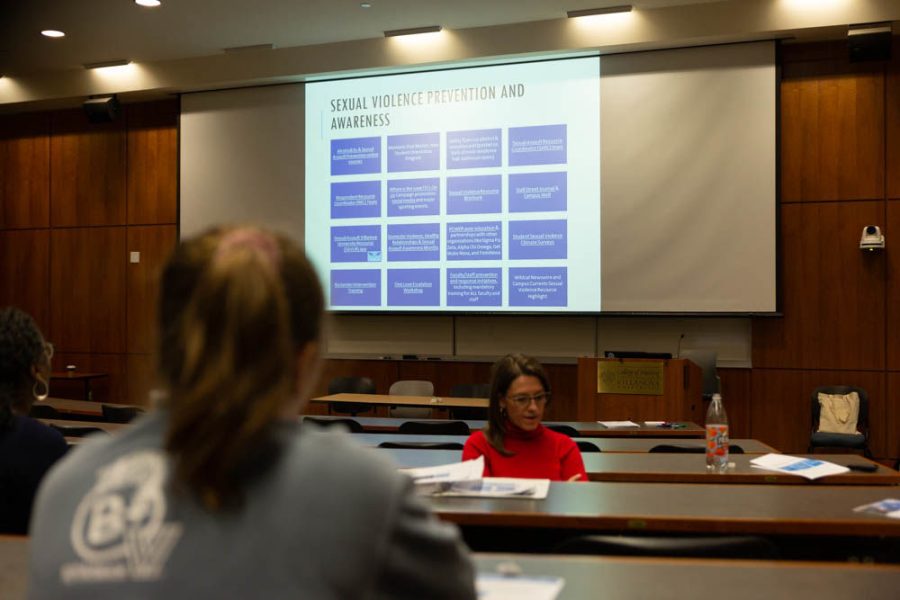University Publishes Key Findings of Second Student Sexual Violence Climate Survey
Courtesy of Maggie Mengel
February 4, 2020
Last fall, the University began its second analysis of the campus sexual violence
climate through an optional survey designed to collect information from anonymous student
reports. Heads of the project, Title IX Coordinator Ryan Rost and Director of Health Promotion
Stacy Andes, released their findings on Jan. 24.
Following the publication, they held two informational sessions designed as open forums for students, faculty and any interested members of the community to discuss their main goals:
prevention, education and awareness. Both forums began, as did the report, with a mention of the school’s mission, resources for victims of sexual violence and prevention efforts. These
initiatives include Villanova’s team of Sexual Assault Research Coordinators (SARCs), which
contains 11 trained professionals who remain on call 24/7. The Sexual Assault Villanova
University Resource (SAVUR) mobile application is designed to offer extensive information for
survivors and assistance in contacting a number of the school’s professional teams, the Stall
Street Journal strives for widespread education and more (to see a full list of the programs
offered to students, see page 11 of the Results of the 2018 Sexual Violence Climate Survey).
Rost and Andes then began to discuss the preliminary findings of the report in comparison to those of the first climate survey in 2015.
Since attending the University, 15.4% of undergraduate women and 2.7% of undergraduate men who participated in the survey reported nonconsensual sexual contact, a slight variation from data collected in the 2015 survey said 15% of undergraduate women and 4.7% of undergraduate men reported nonconsensual contact. Undergraduate women who reported telling “no one” about their experience dropped from 19% to 11%. The percentage of graduate and law students who reported experiences of nonconsensual sexual contact before becoming a student at Villanova was almost double that of undergraduate students who reported nonconsensual sexual contact prior to becoming a student at Villanova. Both undergraduate men and women reported a reduction in their perpetrators alleged use of alcohol from the previous survey; women’s reports dropped from 82% to 65% and men’s dropped 90% to 40%.
On a scale from 1-7, undergraduate women consistently scored higher in “agreement” with feeling aware of the sexual violence climate and eager to reduce the occurrence, while the men consistently scored higher in “agreement” with statements suggesting sexual violence is not an issue and the responsibility to help lies on the administration. Of the undergraduate females who reported assaults, 57% said their experiences occurred during their first year of enrollment. However, this data has its limitations. Out of the 7,065 undergraduates who received the survey, only 33% responded and closer to 20% of graduate students responded.
It’s understandable though, as Rost and Andes pointed out, that some students choose to opt out of participating. Students may have felt like the survey didn’t apply to them, found it too difficult to answer or worried about the anonymity of it. Regardless, this lack of participation creates a question of accuracy. Depending on the question at hand, one can look to national data to see how well the reports’ numbers align with other reports.
For example, the 15.4% of undergraduate women reports falls below the
often-noted “one-in-five” statistic (referring to the number of women reporting sexual violence
during their time in college, which is often debated) and the American Association of Universities’ data compilation that collectively offered a rate of 25.9% of undergraduate women experiencing nonconsensual sexual contact. In fact, the general low numbers can directly cause the removal of certain data altogether. Within the survey, data from students identifying as transgender or gender non-conforming was reviewed but not included in the report due to the ethical limitations, as responses encompassed less than 10 students. These small numbers may limit the school’s encompassing understanding of the climate as a whole. That said, administration behind the survey remains hopeful and eager to take a deeper dive into campus culture.
During the forums, Rost and Andes mentioned their future plans to hone into specificities within the data—looking for trends across certain social groups, academic groups or schools and athletic groups. For those interested, stay tuned for further conversations and various ways to get involved in the movement. When the original survey was developed in 2015, the forum discussion held more than 50 interested students, but unfortunately this past week, attendance proved to drop to half of that. Students can log into their “My Nova” account, under “2018-
Sexual Violence Climate Survey,” to see the full report.
*This article was updated on Tuesday, Feb. 11 to address inaccuracies in the previous issue.


